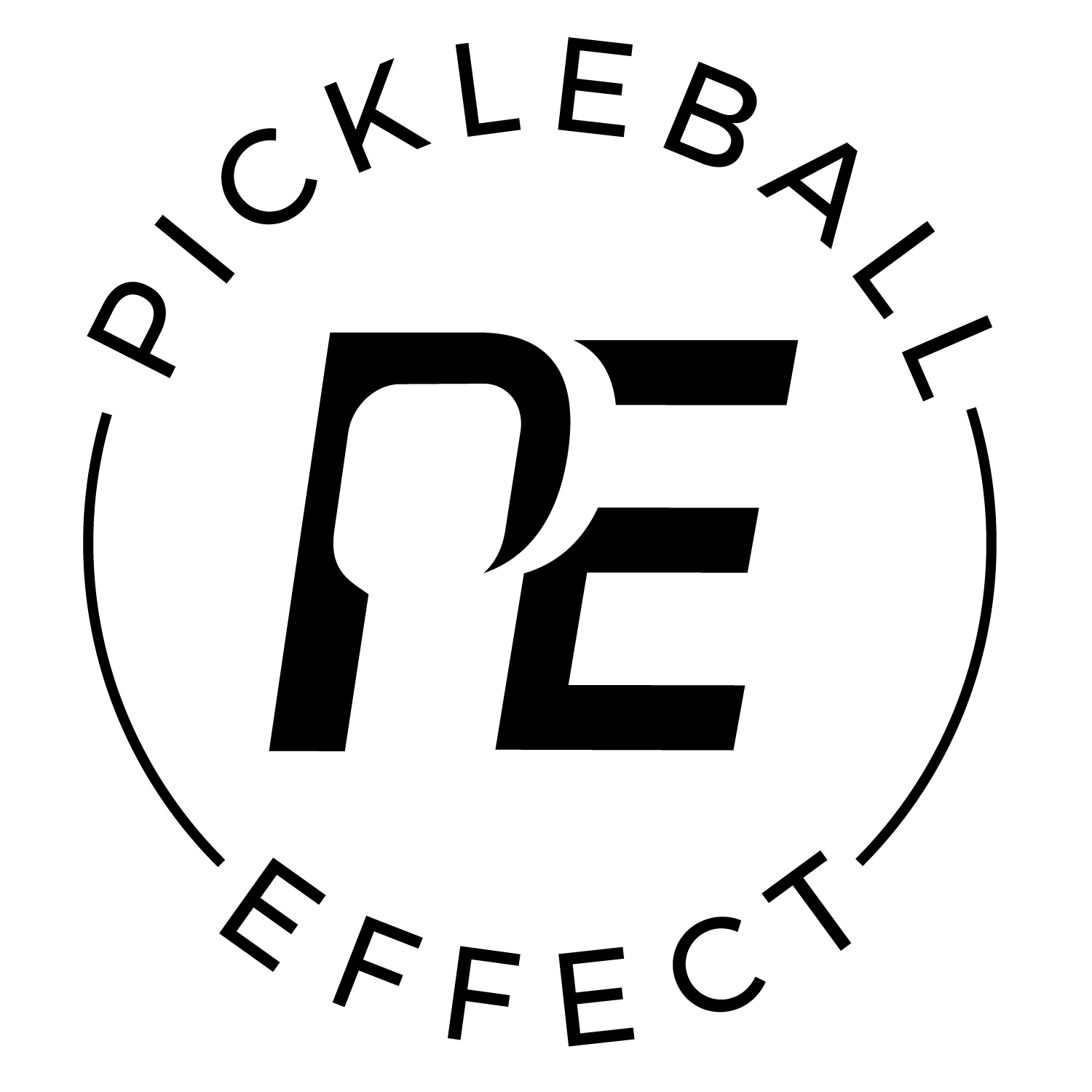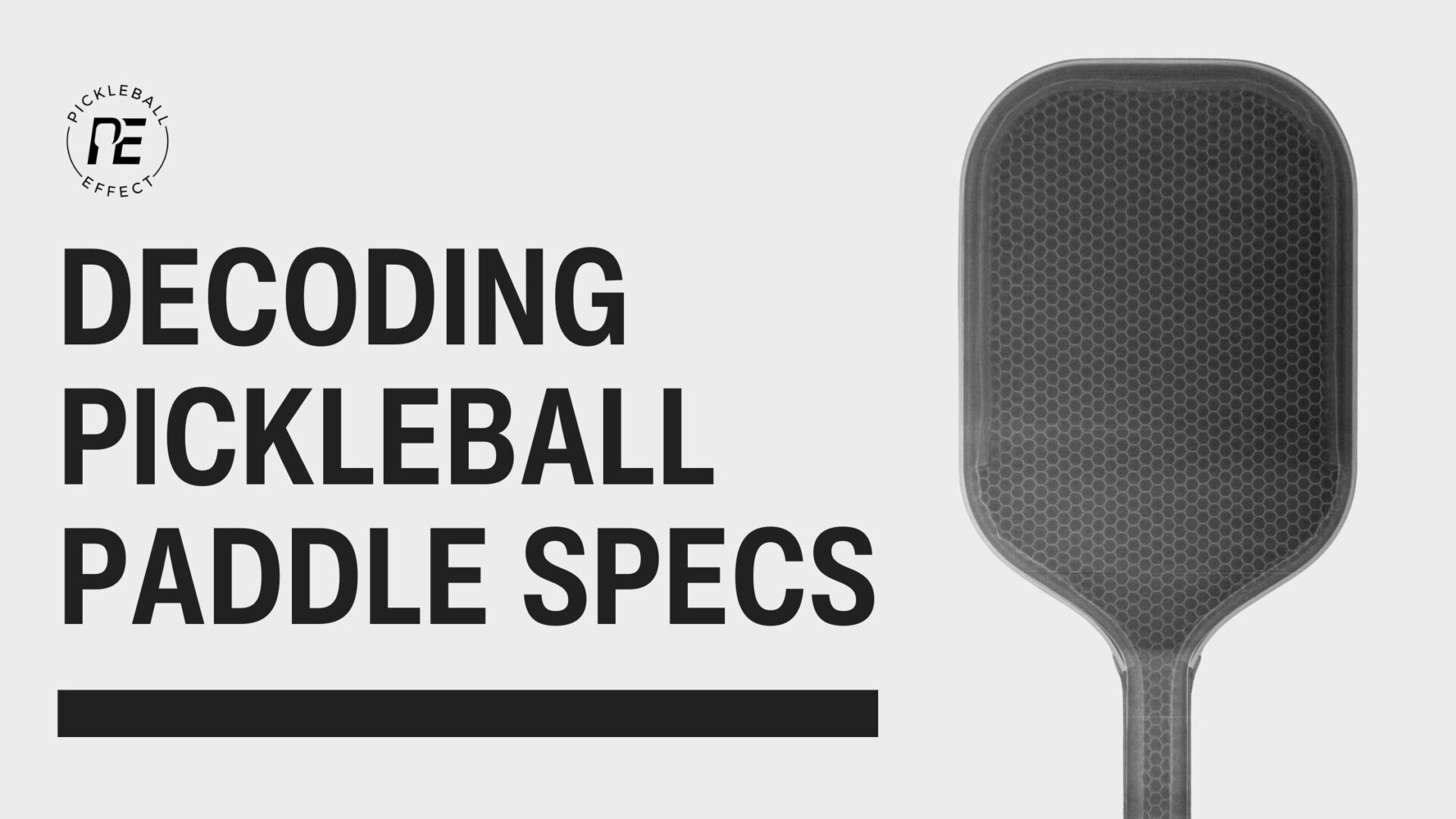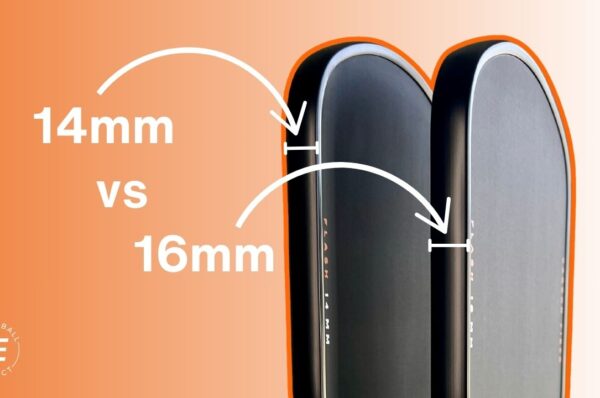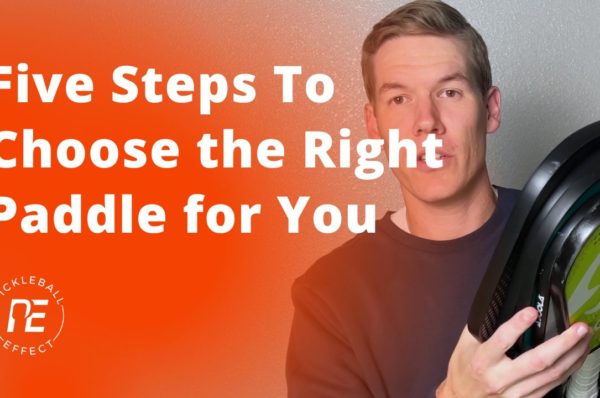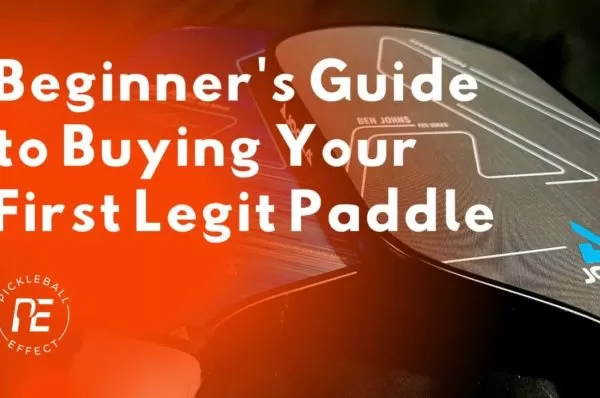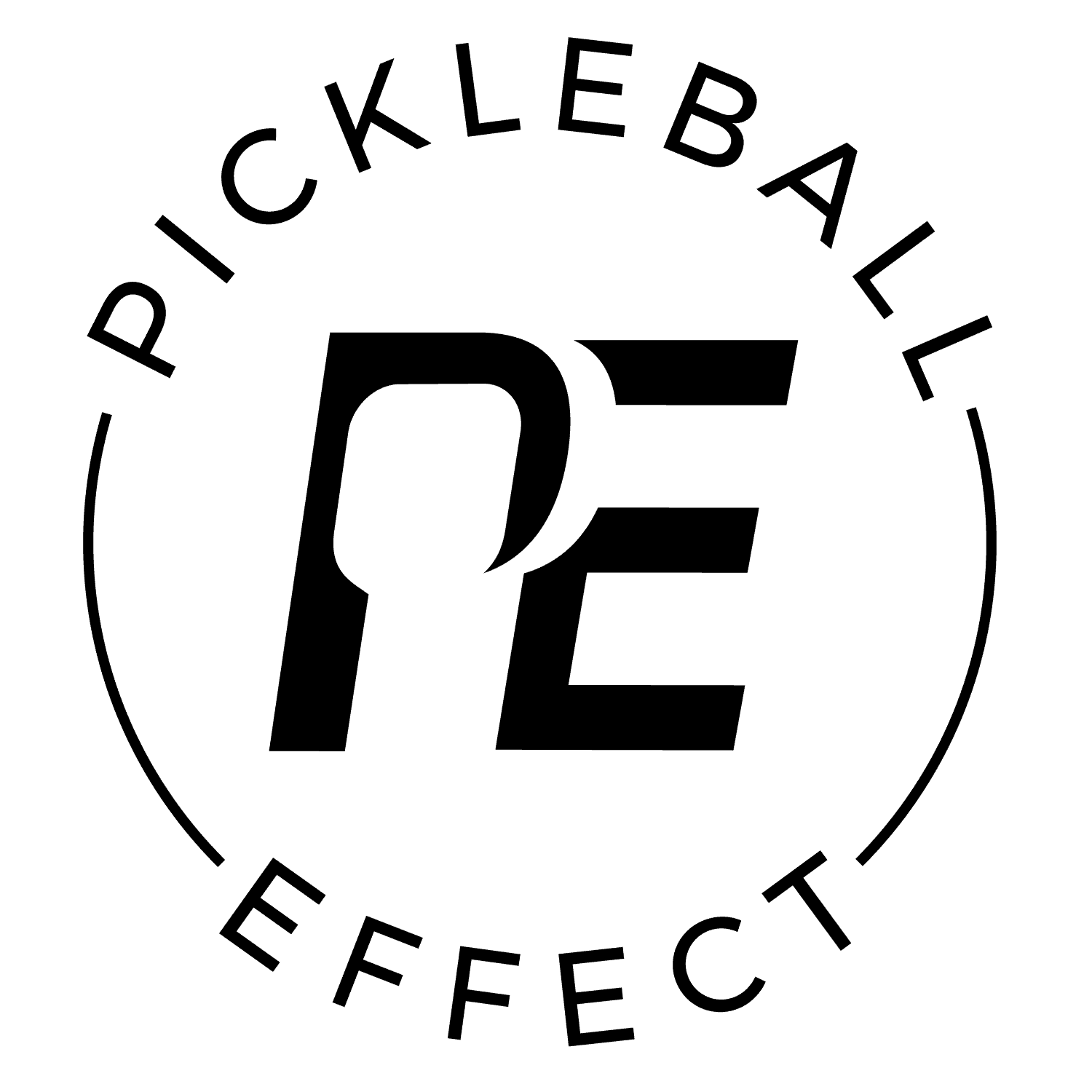There are about twenty mainstream paddle brands and many more knock-off brands, offering hundreds of different paddles to choose from. Most paddle companies use similar marketing, claiming their paddles offer the perfect blend of power and control. This makes it difficult to determine the unique qualities of each paddle.
This pickleball paddle buying guide teaches you which paddle specifications to prioritize and how to interpret a paddle’s spec sheet and jargon to get a general idea of its playing style. This in-depth guide is not for the faint of heart, so get ready to get nerdy.
While this guide is great for learning about different construction methods, I also have another guide on how to pick the right paddle for you that focuses more on performance needs rather than nerdy specs. You can check that out here if that’s more your style.
Paddle Specs You Need To Pay Attention To
I’ve been reviewing paddles since 2021 and have come up with these five things you should pay attention to when looking at a paddle’s spec sheet. Combining these five elements together gives you a pretty good idea of what you can expect from the paddles performance wise.
- The core thickness and material
- Paddle shape
- Facing layup and materials
- Weight distribution (static weight, swingweight, twistweight)
- Construction method (cold pressed, thermoformed, floating core, etc)
Here we go, let’s get into the details.
Table of Contents
Get Discounts on Pickleball Gear
Receive up to 15% off paddles and gear from major brands like JOOLA, CRBN, Engage, Bread & Butter and others.
Core Material and Thickness
Core Thickness
The thickness of the paddle heavily influences the feel, stability, and performance of a paddle. You’ll see paddle thicknesses range from 10mm to 20mm thick. The most common being 16mm and 14mm. You’ll see paddles offered in a 16mm and 14mm option all the time.
Thicker cores: 16mm is considered a thick core paddle and is the most common paddle core thickness. It offers better stability, a larger sweet spot, and absorbs pace better than 14mm paddles, resulting in a more user-friendly experience. However, 16mm paddles are less maneuverable and less offensive than 14mm paddles. Paddles thicker than 16mm are unnecessary in most cases, but can be useful for paddles without edge guards to add stability.
Thinner cores: 14mm paddles are the most common thinner core paddles you’ll come across. These are more maneuverable and poppy compared to 16mm paddles which make them more offensive in general, though you give up some stability and plowthrough with them. While less common than 16mm paddles, they have their place.
Generally, a thicker core increases softness, sweet spot size, and control. Conversely, a thinner core results in a firmer feel, more pop, and a smaller sweet spot. For more in depth information here you can check out this article and video below.
Core Material
There are two primary core materials: polymer/polypropylene and foam. Polypropylene has dominated the market for many years and remains the most common material. Foam cores are a new alternative that has started to enter the market as of 2025.
Polymer/Polypropylene: This is a plastic material that is arranged in a honeycomb structure. There are a variety of ways to manipulate this core to get different performance results. Some brands are more transparent with the type of polymer core they use but sometimes we’re left in the dark. I’ve started using x-rays in my reviews to get a look at these types of things because brands don’t always tell us. Let’s break those different elements down.
Honeycomb cell size. Cell size affects paddle rebound, power, sweet spot size, and consistency. Larger cells (10mm) offer more power and rebound, but a smaller sweet spot and less consistent bounce. Smaller cells (6mm) offer less power, but a more controlled, consistent bounce, denser feel and better sweet spot. 8mm is the most common cell size.
Honeycomb cell wall thickness. This one isn’t often reported on by brands but it does affect performance. Thinner cell walls give you more power and pop while thicker cell walls give you more control.
Polymer density. This is the hardest one to determine and you don’t see it in the spec sheet but it is a factor. Some polymer materials are softer and more flexible while others are rigid. Softer polymers give you more power and pop while rigid cores give you more control.
Foam additions. Foam is sometimes added around the perimeter of the polymer core in varying amounts, which will change how the paddle plays. Depending on location, density, and amount it can add power, reduce vibrations, or improve stability. This element is nuanced, and its effect on performance varies. Therefore, I can’t give you specifics here but will discuss this further in the Construction Method section.
You’ll see brands advertise what cell size they use sometimes, but you’ll rarely see brands report on cell wall thickness and polymer density. That information comes from paddle tear downs that me and other reviewers do.
Solid Foam Cores: This is a new type of core that was introduced in 2025. While there is still a lot to learn about foam cores, they are different from polymer cores in that they offer a softer impact feel and have increased durability in the fact that they hold their shape and playing characteristics better over time.
Foam cores were introduced in 2025. While there is still a lot to learn about them, it is clear that they differ from polymer cores. Foam cores offer a softer impact feel and retain their shape and playing characteristics for longer, increasing their overall durability vs polymer cores. The first popular foam core paddle was the CRBN TruFoam Genesis series. You can check out my review for it here.
I’ll update this section as I learn more but it seems that the main difference between foam cores of the future will come down to the type and density of the foam used and if they make designs in the core like CRBN did or not.
How Does the Core and Its Thickness Impact Which Paddle I Choose
The paddle’s core and thickness influence its performance more than other factors. When researching paddles, prioritize these elements over other elements we talk about below.
Get Discounts on Pickleball Gear
Receive up to 15% off paddles and gear from major brands like JOOLA, CRBN, Engage, Bread & Butter and others.
Paddle Shape
Understanding shapes and how they impact paddle performance is one of the more important things you should consider next to the paddle core and thickness. The shape of a paddle is determined by its length and width. USAP rules state that the combined length and width of a paddle cannot exceed 24 inches. Within these guidelines, three general paddle shapes have emerged: elongated, hybrid, and widebody. Let’s explore each shape and its benefits to help you find the best fit for your needs.
Paddle shape dimensions:
Elongated: The dimensions for an elongated paddle are 16.5″ x 7.5″. Or anything longer than 16.5” though 16.5” makes up the vast majority of paddles in this category.
Hybrid: A hybrid shaped paddle falls somewhere in between the standard and elongated shapes, with approximate dimensions of 16.25″ x 7.5-7.7″.
Widebody: A widebody shaped paddle has dimensions of 16″ x 8″ and also includes anything shorter than 16”. You’ll see this shape called “standard” sometimes too.
Characteristics of each paddle shape:
Elongated: An elongated paddle offers increased reach, spin, and power. This increased reach, however, reduces forgiveness, particularly from side-to-side, and makes the paddle more head heavy than other options.
Hybrid: The hybrid shape, a middle ground between elongated and widebody shapes, balances reach and forgiveness, offering players a versatile option that combines aspects of both.
Widebody: A widebody paddle sacrifices some reach and power for increased forgiveness and maneuverability. Its reduced head heaviness and wider design enhances control and stability.
Shape Recommendation
I believe that hybrid and widebody shapes are superior for most players. They are less head heavy, more forgiving, and easier to customize with added weight. A few years ago, the head-heavy and longer design of an elongated paddle was the best option for generating power, but paddle technology has advanced significantly. Now, you can find power in every shape. If you want extra reach, choose a hybrid shape; if you want speed and an oversized sweet spot, choose a widebody.
Pro players primarily use elongated paddles, but they prioritize power and pop over sweet spot size and control. I think pro players using elongated paddles has negatively influenced amateurs. In reality, hybrid and widebody shapes are better options for most players.
Facing Materials and Layups
There are four main facing materials commonly used: carbon fiber, fiberglass, kevlar, and titanium (polyester weave). The facing layer material, number of layers, and the type of material used in the layers affect a paddle’s performance. I’ll first describe how each material affects the paddle and then I’ll talk about how you can combine the types of materials in different layups to get a variety of results.
Fiberglass: This is the most flexible and powerful of the four materials and can be used in a few different facing layups to achieve different results. Although it is the most powerful, it also feels the harshest and stiffest at impact and produces a smaller sweet spot.
Kevlar or aramid: Kevlar, while very similar in performance to carbon fiber, is slightly more powerful than it though less powerful than fiberglass. It offers a feel that falls between the harshness of fiberglass and the softness of carbon fiber as well. Kevlar is frequently used as the top facing sheet and can be interwoven with carbon fiber. Some brands favor kevlar over carbon fiber due to its color versatility, which allows for more design options compared to carbon fiber’s limited black color.
Carbon fiber: Carbon fiber, the most common paddle material, is known for its large sweet spot and good control. Though the material is physically stiffer than fiberglass and kevlar, it produces a softer feel and power level just below kevlar. Different types, like t700 and t300, vary in stiffness, but performance differences are subtle. You will see carbon fiber advertised on very inexpensive paddles and they are often using a lower quality carbon fiber so you need to watch out for that. Anything that says t700 carbon fiber is usually a good choice.
Titanium (polyester weave): Titanium was introduced in 2024 as a new material for paddles. It has a softer impact feel and is less poppy than carbon fiber, while still offering similar power levels. Due to its softer feel and reduced pop, it is recognized as a good material for control-style paddles. It can also be combined with other materials to create varied performance effects.
Understanding Facing Layups
Paddles will have more than one facing sheet applied to the surface. You can have three layers of carbon fiber, or two layers of carbon fiber with a kevlar top facing sheet. You can arrange the materials above in a variety of ways to get different results. Here are a few examples of the most common layups you’ll see.
Carbon, carbon, fiberglass (CCF): This configuration features two carbon layers on top and a fiberglass layer on the bottom. This setup provides excellent control and a softer feel on shorter swings like dinks. On bigger swings like serves and drives, the third fiberglass layer is activated for increased power.
Carbon, fiberglass, carbon (CFC): This setup provides easier access to pop than the CCF layup, allowing you to reach the fiberglass layer more easily. This results in increased ball speed on short strokes like counters, while still maintaining some control on other shots.
Carbon, carbon, carbon (CCC): This setup gives you a bigger sweet spot and more control.
There are countless ways to combine materials into layups, and the way these layups interact with the overall paddle design is crucial. Smart brands will utilize layup configurations to either enhance or compensate for other aspects of the paddle. For instance, a titanium top facing layer on a firm, thin core paddle can soften the overall feel. And while the three layup example above are common, you’ll see brands use a different number of facing layers than just three.
Here’s a fun video I made looking at carbon fiber, kevlar, and titanium specifically since those are the newest materials to surface.
Weight Distribution (Static Weight, Swingweight, Twistweight)
When shopping for paddles, you’ll notice that most are listed around 8 oz. However, the weight can be distributed differently, affecting how the paddle plays. Even if two paddles weigh the same, they may feel and move differently during play.
You should pay attention to the paddle’s static weight and make sure it’s within a reasonable range (between 7.5 and 8.3 oz). However, I prioritize the swingweight and twistweight of the paddle as those describe how the paddle moves and plays better than the static weight does.
Swingweight: Swingweight is a measure of the paddle’s resistance to swinging about the end of the handle. The higher the swingweight number the heavier it will feel in your hands. A higher swingweight has more power but is harder to swing, lower swingweight is easier to swing but has less power. Sometimes a faster swing with a lower swingweight can make up for power lost in swingweight. The price paid for that is greater impact shock. Stock swingweights will vary between 100 – 140.
Twistweight: Twistweight is the resistance to rotating around the long axis through the middle of the paddle from butt to tip. The higher the twistweight the more resistance the paddle has to rotating on off center hits. This measurement is closely related to the amount of forgiveness or the size of the sweet spot of the paddle. A higher twistweight indicates a bigger sweet spot. Twistweight numbers range from 5 – 8.
Now that we understand these terms technically, let’s talk about how to apply them in your paddle search. If you’re unfamiliar with these numbers, I recommend looking for paddles with a swingweight between 112 and 118 and a twistweight above 6. This range offers a well-balanced paddle with a good sweet spot. Remember that elongated paddles will feel more head-heavy and typically have a swing weight between 116 and 124 and a lower twistweight measurement. Hybrid paddles usually fall between 113 and 118 swingweight and have a mid range twistweight measurement, and widebody paddles are between 108 and 114 swingweight and have higher twistweight measurements. In short, the longer the paddle, the heavier it will feel, and the shorter the paddle, the lighter it will feel.
You can also check out my paddle database here to see if I have your current paddle in there and you can see what its swingweight and twistweight measurements are to get an idea of what your preferences are.
Construction Method
The construction of a paddle can indicate some of its play characteristics. However, like the other factors mentioned above, it doesn’t always provide a complete picture and is just one contributing factor.
You’ll see reviewers and brands refer to these different construction methods as generations (e.g., Gen 1, Gen 2), since they were adopted in that order. However, a newer construction method isn’t necessarily superior to an older one.
Cold Pressed (Gen 1): In the cold pressing construction method, the paddle’s facing layers are adhered to the polymer core, and then an edge guard is wrapped around it. While this construction is often recognized for producing a plush feel and control-oriented paddle, this is not always the outcome.
Light Thermoforming (Gen 1.5): Introduced in 2023. This unique category encompasses paddles constructed similarly to Gen 1, cold-pressed paddles, but with the added feature of expanding foam injected around the perimeter. The foam is contained by a layer of carbon fiber, which is then heated and pressurized slightly to expand the foam before an edge guard is applied. These paddles are also recognized for their control style.
Full Thermoforming (Gen 2): Introduced in 2023. Thermoformed paddles are made by applying heat to fuse the facing layers and a carbon fiber perimeter. They often have foam injected around the edges and are known for power and stability, usually falling into the all-court category. This style is similar to Gen 1.5, except it undergoes additional heat and pressure to create a more rigid carbon edge, which further stiffens the paddle.
Widened Foam Edge (Gen 3): Introduced in 2024. Paddles in this category, similar to Gen 2 paddles, utilize thermoforming but incorporate additional foam around the perimeter, creating a dual foam wall. Popularized by JOOLA, this method can vary by adjusting the type and amount of foam used around the perimeter. While generally categorized as power paddles due to their increased power, this is not always the case.
Full Foam Core (Gen 4): Introduced in 2025. Paddles in this category utilize a full foam core, a departure from the polypropylene cores used in previous generations. Popularized by CRBN, this method can produce a variety of paddle types and is known for enhancing feel and durability compared to polypropylene cores. As this technology is still new to the industry, it continues to be evaluated and developed.
How Does Knowing the Construction Method Impact What Paddle I Choose?
Knowing the construction method can indicate some play characteristics, but it’s less important than the factors mentioned above when looking at a paddle’s spec sheet. People tend to get caught up in the tech here, but I don’t find it to be as important because it’s not as descriptive of the paddle itself as the other specs are.
It is important to note that Generation 1.5 paddles and beyond tend to be more forgiving and offer a wider range of paddle profiles. Generation 1 and 1.5 paddles are generally more durable and do not degrade as quickly as Generation 2 or 3 paddles. Generation 4 paddles show promise as a more durable material, and we will continue to monitor their development.
Final Thoughts
I’m a big paddle nerd. I love learning about the different aspects of a paddle and how they affect performance. There are so many ways to mix and match these aspects, as discussed in this article. Once you understand them, you can look at the spec sheet of almost any paddle and get a good idea of how it plays, making it easy to shop for paddles.
Not everyone gets into this nerdy stuff like I do. So, I wrote another paddle selection guide here that speaks more to the outputs and performance aspects you should look at to match a paddle to your game, without getting too technical. It’s easier to follow and use. Check it out if that’s more your style.
Get Discounts on Pickleball Gear
Receive up to 15% off paddles and gear from major brands like JOOLA, CRBN, Engage, Bread & Butter and others.
